Although this area was settled as early as 600 BCE, the culture flourished from about 600-900 CE when Becán was the center of the Rio Bec region. This heavily populated area (including for example the cities of Xpujil and Chicanná) developed a unique architectural style: its temples have two or three tall towers lined up in a row and with a single story building linking them; the extremely steep towers, designed primarily effect, often had false staircases; elements of the Chenes style were also incorporated, especially the use of the monster-mask entrance.
|
The dry moatThe name becán in Maya means "ditch of water." This is the only known Mayan city with a moat, although later inhabitants apparently used it as a refuse dump. The city was also surrounded with a solid wall for fortifications. |

|
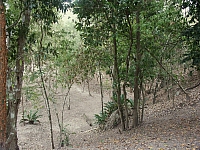
|
| |
|
This fortified city was built around several plazas with buildings group around them. (See map.) Today one enters on the southeast side and almost immediately sees the acropolis. This high platform contains four structures, grouped around the East Plaza.The East Plaza with Structures I, II, III, IV
|
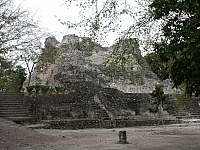
|

|
Structure I from the southThis massive building with pseudo stairways, rounded corners, and two huge towers actually faces south (away from the central courtyard). Two levels of rooms are below the towers. |
| |
|
Structure IIThe facade of this building is the most intact of the groping. Note the checkerboard and cross stone mosaic patterns. |

|
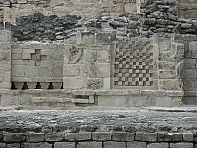
|
| |
|
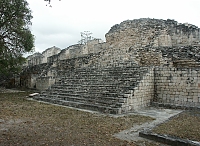
|

|
Structure III and small altar (with Structure IV in the background)The rooms are well-preserved in this building--including a steam bath. The altar is a later addition to the plaza, dated at about 1200 CE. |
| |
|
Structure IVStanding on the north side of the plaza, this building has a steep staircase to a wide temple at the top. Remnants of the monster mask at the doorway are still visible. |

|
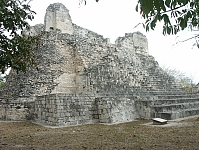
|
| |
|
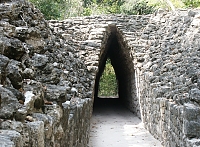
|
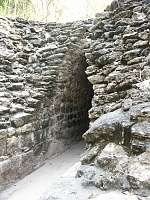
|
The vaulted tunnelThis Mayan "street" leads west to the Central Plaza. (See map.) |














 Go to the Mexico Index.
Go to the Mexico Index. Click here to return to index of art historical sites.
Click here to return to index of art historical sites.
 Click here to return to index of artists and architects.
Click here to return to index of artists and architects.
 Click here to return to chronological index.
Click here to return to chronological index.
 Click here to see the home page of Bluffton College.
Click here to see the home page of Bluffton College.
